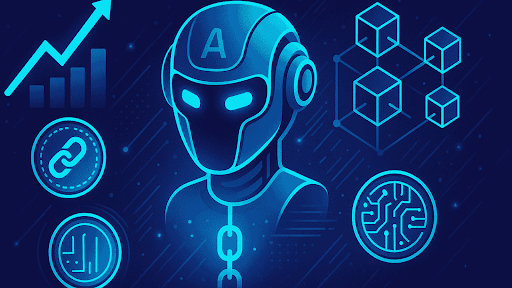On‑chain artificial intelligence activity has surged by an impressive 86 percent in 2025, marking a paradigm shift in how blockchains and AI interact at scale. This spike reflects a wave of interest in decentralized agents performing complex tasks, from arbitrage trading to automated governance voting. This article examines the drivers behind this surge, the technologies enabling it, and what it means for the future of AI and blockchain convergence.
The Rise of Autonomous On‑Chain Agents
Decentralized AI agents are smart contracts equipped with decision-making capabilities that execute predefined tasks autonomously. Using real-time data feeds, machine learning models, and oracle integrations, these agents can monitor markets, execute transactions, manage liquidity, and even participate in governance. Their emergence recognises that for blockchain ecosystems to mature, they must not only store and transfer data but also process and act on it without human intervention.
By enabling smarter and more cost‑efficient operations, decentralized agents are transforming how decentralized finance, gaming, and decentralized identity systems function.
Key Drivers Behind the 86 Percent Jump
Several intersecting trends explain this rapid expansion of on‑chain AI activity:
Scalable Blockchains: 2025 has seen multiple layer‑1 and layer‑2 platforms enhance throughput and reduce latency, making real-time agent execution more viable. With transactions finalised in seconds and indexed data structures optimized for query systems, deploying intelligent agents at scale is now practical.
Accessible AI Models: Pre‑trained AI models—ranging from market sentiment analysers to predictive pricing engines—are now available as APIs or smart contracts. Developers can integrate these models without reinventing algorithms, enabling rapid agent deployment.
Incentive Mechanisms: Protocols are embedding tokenized incentives to encourage AI agent usage. From staking to yield farming based on agent uptime and performance, token economies are aligning developer interest with real‑world use case deployment.
Oracle Infrastructure: Secure oracles like Chainlink and UMA now support more advanced data types, including AI training inputs and model outputs. This reliability makes agents both trusted and transparent on‑chain.
High‑Impact Use Cases Emerging in 2025
The surge isn’t just numerical—it’s being driven by real initiatives:
- DeFi automation: Agents are rebalancing liquidity pools in response to volatility, capturing arbitrage across exchanges.
- Automated settlement: Real‑world asset platforms are using agents to trigger payments and custody actions based on contract terms like escrow triggers.
- Governance participation: DAO‑run agents are executing votes on proposals, with machine checkpoints scanning sentiment and casting informed votes on behalf of a voter’s preferences.
- Dynamic NFTs: AI agents monitor artwork or asset performance and automatically modify metadata or unlock features when milestones are reached.
These implementations showcase that tools are moving from proof‑of‑concepts to production‑level projects.
Ecosystem Integration and Developer Activity
The growth in AI agent deployment is supported by vibrant ecosystems:
- Agent runner platforms such as Autonolas and Fetch.ai are offering developer kits and runtime environments tailored for autonomous on‑chain logic.
- Hackathons and grants have centered around decentralized AI challenges, with major platforms funding agent pilots in verticals such as gaming, IoT, insurance, and carbon markets.
- Rise of composability: Agents built on one chain are being called by agents or smart contracts on others, fostering cross‑chain execution and collaboration.
This ecosystem richness reinforces why AI‑on‑chain usage is growing sustainably.
Challenges and Security Considerations
While growth is strong, it comes with fresh risks:
- Model reliability: AI models must be audited continuously to avoid faulty or malicious logic making incorrect decisions on‑chain.
- Oracle manipulation: Agents relying on external data require secure infrastructure to prevent exploits.
- Gas costs: Executing on-chain reasoning is costly; efficient transaction batching and optimized execution environments are becoming critical.
- Governance conflicts: Autonomous agents may execute actions not fully anticipated by the DAO voters who authorised them, raising accountability questions.
Mitigating these risks is now a central focus for developer communities and protocol teams.
What to Monitor Moving Forward
As decentralized agents and AI‑on‑chain volume continue to grow, key metrics to watch include:
- Agent deployment rate: Number of smart contracts flagged as AI‑powered or self‑executing, especially across DeFi and DAO platforms
- Transaction density led by agents: Share of blockspace consumed by AI-related transactions
- Performance data: Measures such as arbitrage efficiency, trade success ratio, and governance voting accuracy
- Security events: Notable exploits or failures tied to agent logic and how fast patches are deployed
Tracking these will help gauge how smoothly AI agents integrate deeper across Web3.
Conclusion
The remarkable 86 percent surge in AI‑on‑chain transactions in 2025 confirms that decentralized agents are no longer conceptual—they are now foundational infrastructure. By automating finance, governance, and NFT ecosystems, these intelligent systems are shaping the future of Web3. Careful protocol design, robust security, and transparent governance will determine whether this tipping point leads to sustainable transformation.

